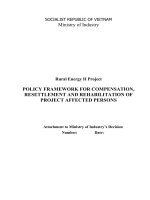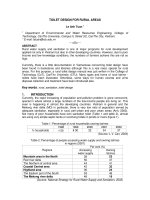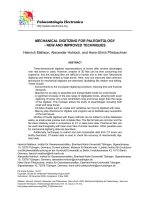Tài liệu Toilet design for rural areas and separated urine collection as a fertilizer source pptx
Bạn đang xem bản rút gọn của tài liệu. Xem và tải ngay bản đầy đủ của tài liệu tại đây (620.5 KB, 7 trang )
SANSED WORKSHOP - 14-16 June, 2005, CanTho University, Vietnam
Toilet designs for rural areas and 1
separated urine collection as a fertilizer source
TOILET DESIGN FOR RURAL AREAS
AND
SEPARATED URINE COLLECTION AS A FERTILIZER SOURCE
Le Anh Tuan
1*
, Joachchim Clemens
2
, Duong Van Ni
3
, Nguyen Thanh Phong
1**
1
Department of Environmental and Water Resources Engineering, College of
Technology, CanTho University, Campus II, Street 3/2, CanTho City, Vietnam.
* E-mail: , ** E-mail:
2
Institute of Plant Nutrition, University of Boon, Karlrobert-Kreiten-St. 13, D-53115 Bonn,
Germany. E-mail:
3
Mekong Delta Development
Institute, CanTho University, Campus II, Street 3/2,
CanTho City, Vietnam. E-mail:
oOo
ABSTRACT
Rural water supply and sanitation is one of major programs for rural development
applied not only in Vietnam but also in other developing countries. However, due to poor
income and low knowledge conditions, the numbers of farmers achieve this are not so
high.
Currently, there is a little documentation in Vietnamese concerning toilet design have
been found in bookstores and libraries although this is a real need, special for rural
areas. For this purpose, a rural toilet design manual was just written in the College of
Technology (CoT), CanTho University (CTU). Many types and forms of rural latrine -
toilets have been illustrated. Otherwise, some ways for human excreta and urine
disposal collection and treatment have been introduced also.
Urine contains a very high of the excremental nutrients. Separated urine collection for
mineral fertilizer is researching in CTU. First, some initials experiments on odorless urine
condensation are being done. A design of urinating blocks for pupils with separated
urine collection and treatment system will be drawn. Then, a pilot one will be built in a
selected rural school. From this pilot result, a further action plan on urine collection for
mineral fertilizer production will be made.
Key words: rural, sanitation, toilet design, urine collection, mineral fertilizer
1. INTRODUCTION
Currently, the rapid increasing of population and pollution problem is gone concurrent,
special in where almost a large numbers of the low-income people are living on. This
even is happening in almost the developing countries. Vietnam in general and the
Mekong river delta (MD) in particular, there is very low ratio of population served by
adequate sanitation, especially in rural, peri-urban and poor urban areas (Anh, 2002).
Not many of poor households have own sanitation toilet (Table 1 and table 2), almost
are using very simple septic tanks or overhung toilets in ponds or rivers (figure 1).
Table 1: Percentage of rural households owning latrines
1998 1999 2000 2001 2002
% households
20
# 30 32 34 37
(Source: L.V. Can, 2003)
SANSED WORKSHOP - 14-16 June, 2005, CanTho University, Vietnam
Toilet designs for rural areas and 2
separated urine collection as a fertilizer source
Table 2: Percentage of people accessing water supply and owning latrines
in regions (2001)
Per cent (%)
Regions
Accessing
water supply
Owning
latrines
Mountain area in the North
39
23
Red river delta 50 47
The Northern of central area 44 41
Coastal Central area
42
32
Highland area
36
24
The Eastern part of the South 53 46
The Mekong river delta
48
19
(Source: National Strategy for Rural Water Supply and Sanitation, 2003)
Figure 1: Overhung toilet in pond in the MD
Vietnamese people once have an idiom "Nhà sạch - Ruộng xanh" ("Clean house - Green
field) considered as a rich and sustainable rural indicator. In 1999, the National Strategy
for Rural Water Supply and Sanitation of Vietnamese Government has stated the goals:
"Up to year 2010, about 70 per cent of households in rural areas have sanitation latrines
and know how to apply personal hygienic" (Decision No. 104/2000/QÐ-TTg, dated 25
Aug. 2000, signed by the Prime Minister). So, for this purpose, there was a campaign
namely "Building 3 sanitation works: water wells, bathrooms and toilets" have been
deployed several years and got some successful in many places in the Northern and the
Central regions of Vietnam. However, this expectation seems not to reach the general
objectives in many rural areas of the Mekong River Delta because of economic
difficulties, low income, the poor of building materials in the countryside and the lack of
required information and skills of communities imply thinking nothing of sanitation needs
in farmers and/or even poor hygiene awareness in rural development staff.
Using toilet is one of actual human needs but it is really hardly to find some Vietnamese
books and documents concerning sanitation facilities and hygienic human waste
treatment in the libraries or bookstores, even simple ones. Otherwise, the ways for
treating the excreta and urine as a source of mineral nutrient fertilizer have applied very
little in the Southern of Vietnam. Humane urine has a high content of nitrogen,
SANSED WORKSHOP - 14-16 June, 2005, CanTho University, Vietnam
Toilet designs for rural areas and 3
separated urine collection as a fertilizer source
phosphorous and potassium (Simon, 2002). Thus, if one can separate the urine and find
a suitable to have a mineral fertilizer and then distribute this fertilizer source back to the
cultivated lands, we may achieve one of the goals for a sustainable eco-agricultural
development. So, the main objectives of this report are to introduce:
A rural toilet design manual, its significance, contents and application.
An experimental concentration of nutrient in human urine.
2. RURAL TOILET DESIGN MANUAL
Currently, the big gaps between the urban people and the rural people in Vietnam are
their income opportunities, living standards, education and health conditions, and others.
As a result, the farmers are limited to receive enough clean water supply and sanitation
facilities as a social beneficiary. Furthermore, their living habits are directed toward the
simple nature. It is difficult to break the thinking to defecate and urinate to the open fields
in farmers and communities' daily life. In general speaking, there are some reasons
listed that have limited the numbers of rural toilet building:
Low in-come;
High cost for a sanitation toilet;
Lack clean water;
Hardly to find good building materials;
Poor awareness in hygiene;
Not to like to defecate in a cramped toilet;
Consider human and animal excrement as a source for fish raising;
Not to be interested fully in local governments and rural development staff;
Very scare information and documents (books, guidebooks, manuals, )
Awareness the uncontrolled and libertine sanitation situation in rural area was a
population cause in water body, since mid-2003 to early-2005, CTU had accepted to
develop a know-how reference document as a manual concerning rural toilet designs
(Figure 2). The main goal of this work is to write a guidebook as a basic knowledge for
farmers, rural development staff and local governments in fixative designing and building
available low-cost toilets. The document emphasizes to reduce soil and water pollution,
to use recycled human waste and to protect environment (Figure 3). It focuses the
technical structures of the rural waterless and water toilets that can be applied in
different rural regions and available financial investment capacity, not only to introduce
some models in other countries but also to improve existing ones. Otherwise the
community based toilet management is introduced.
The structure of the manual, with five chapters totally, follows a logical sequence from
the general pictures of rural toilet situation and problems in Vietnam, as reviewed in
Chapter 1. Basic knowledge on rural toilet sanitation is encountered in Chapter 2.
Coming to Chapter 3, some models of rural waterless toilets are introduced and
analyzed their advantages and disadvantages. Similar, in Chapter 4 presents rural water
toilet structures and also to compare their both sides of cost and benefit. Later, how to
develop and manage toilets in community is discussed generally in Chapter 5. Finally,
additional reading documents as reference are listed. An English - Vietnamese Toilet
Dictionary is also added shortly at the end pages of the manual.
SANSED WORKSHOP - 14-16 June, 2005, CanTho University, Vietnam
Toilet designs for rural areas and 4
separated urine collection as a fertilizer source
Figure 2: Cover of rural toilet design manual
Figure 3: Toilet classification, treatment and reuse system
TRANSFORT
& TREATMENT
TOILET
Waterless
Water
To pond *
Bucket
latrine
Borehole
latrine
Vault
tank
Septic tank
to
i
let
Sludge
Excreta
carrying cart
Collection
vehicle
Biogas
tank
To raise
fish
To raise
earth
worm
To
keep
Storage
pond
To fertilize
field
To raise
poultry
COLLECTION
USE & REUSE
Food
Man
To raise
cattle
SANSED WORKSHOP - 14-16 June, 2005, CanTho University, Vietnam
Toilet designs for rural areas and 5
separated urine collection as a fertilizer source
3. SEPARATED URINE COLLECTION
Urine seems to be a suitable mineral fertilizer if the urine is acidified (pH < 5) in order to
reduce ammonia losses and plant damage (Simon, 2002). There were some data of the
chemical feces and urine composition of the human and animal in Vietnam (Table 3) as
well as average rate of excretion (Table 4).
Table 3: Chemical composition of excreta and urine of the human and animal
Content in % of weight
Source of excretion
P
2
O
5
K
2
O N
Pig dung
Pig urine
Domestic solid waste
Composted pig dung
Human faeces
Human urine
Human excreta and urine
0,45 - 0,6
0,07 - 0,15
0,60
0,25
0,50
0,13
0,20 - 0,4
0,32 - 0,50
0,2 - 0,7
0,60
0,49
0,37
0,19
0,2 - 0,3
0,5 - 0,6
0,3 - 0,5
0,60
0,48
1,00
0,50
0,5 - 0,8
(Source: Duc (1968), Tâm (1984)
Table 4: Average daily human excretion
Feces (grams) Urine (liters)
Adult:
Man
Woman
150
145
1.50
1.35
Child: Boy
Girl
-
-
0.57
0.35
(Source: Tuan, 1981)
Many years before, in some places in Vietnam, human urine has been used for food
plant cultivation. Separated urine from households was collected and stored in a small
jar, farmers have put closed-urine naturally in one to six month and then mixed
"composting urine" to water with an empirical ratio 1:5 or 1:10 before field fertilizer.
According to EcoSanRes, fact sheet 6 stated: "The urine from one person will thus be
enough to fertilize 300-400 m
2
of crop per year and even up to 600 m
2
, if dosed to
replace the phosphorus removed by the crop" (Source: ). A
search from Sweden for volume reduction and concentration of nutrients in human urine
has found that by freezing urine at a temperature of - 14C, approximately 80% of the
nutrients can be concentrated in 25% of the original volume (Lind, 2001). However, this
result can not be applied in Vietnam's weather condition.
For a better understanding the way for urine collection, treatment and application rate in
Vietnam, special in the MD, a proposal research has been established with the steps
(figure 4):
Designing a suitable urine-diverting units likes a school urine collection blocks.
Collected urine will be stored in designed tank.
Mixing urine with acid sulfuric for acidifying to reduce microbial contamination
and ammonia emissions.
Drying the urine by solar and wind energy.
Collecting "drying urine" as mineral fertilizer and transporting it to the fields.
Testing applicable using urine fertilizer in some crops.
Recording all experimental analysis and farmers feedbacks.
SANSED WORKSHOP - 14-16 June, 2005, CanTho University, Vietnam
Toilet designs for rural areas and 6
separated urine collection as a fertilizer source
Figure 4: Conceptual idea on nutrient cycle in urine collection, treatment and reuse
Nitrogen in the urine is in the form of urea, CO(NH
2
)
2
, which can rapidly hydrolyze
ammonium carbonate (Anderson, 2003) as reactions (1), (2) and (3):
CO(NH
2
)
2
+ 3H
2
O (NH
4
)
2
CO
3
+ H
2
O (1)
(NH
4
)
2
CO
3
+ H
2
O 2NH
4
+
+ HCO
3
-
+ OH
-
(2)
NH
4
+
NH
3
+ H
+
(3)
It is foreseen that there are some advantages in using "dry urine fertilizer" research in
the practice:
Urine is salvaged as a natural mineral fertilizer.
Urine is treated to become a solid and small volume fertilizer.
Urine fertilizer is lower risk of pathogen than composting one.
Urine fertilizer quality is higher and cheaper than chemical fertilizers
Urine fertilizer will contribute their role in environmental protection.
However, some other disadvantages may be found:
Urine is hardly to collect, special in rural areas.
Urine may lead a bad smell if having a careless treatment.
Urine fertilizer production organization is not easy to persuade farmers,
commercial investors and local government.
Solar energy
Wind
Urine collection
Urine storage
and treatment
Urine
fertilizer
Fields
FOOD
Eating
Glass lid
SANSED WORKSHOP - 14-16 June, 2005, CanTho University, Vietnam
Toilet designs for rural areas and 7
separated urine collection as a fertilizer source
4. DISCUSSION
It is necessary to distribute widely the know-how technology to the farmers. The aim of
this research is to help rural communities some available low-cost technical documents.
The rural toilet design manual has finished its final draft and being last edited. We need
a financial support for publication.
A study of separated urine collection and treatment is going on. It is an interesting
research with full of promise in theory but there are some rocky application in practice as
mentions above. Anyway, urine applicable for rural development has very useful and
meaningful not in social economic but also in eco-environmental protection.
5. ACKNOWLEDEMENTS
The authors would like to thank financial support from CTU through his science research
fund for development the manual and Germany Government through the SANSED
project for implementation the urine research. We would also like to acknowledge all the
teaching and support staff of the Department of Environmental and Water Resources
Engineering and HoaAn biodiversity experimental station for their spirit support and
allowance to use the laboratories equipment and facilities for our on-going research.
REFERENCES
Anderson, A.; Strader,. R, Davidson, C. (2003). Airborne reduced nitrogen: ammonia
emissions from agriculture and other sources. Environmental International 29
(2003). pp. 277-286. Available online at .
Anh, N.V.; Ha, T.D.; Nhue, T.H.; Heinss, U.; Morel, A.; Moura, M.; Schertenleib, R.,
(2002). Decentralized wastewater treatment - new concept and technologies for
Vietnamese conditions. IWA: 5th specialized conference on small water and
wastewater treatment systems. Istanbul-Turky, 24-26 Sep.
Can L.V. (2003). Rural domestic water supply and sanitation. Agriculture and Rural
development Journal 2(2003). Vietnam.
Lind, B.; Ban, Z.; Stefan, B. (2001). Volume reduction and concentration of nutrients in
human urine. Ecological Engineering 16 (2001). pp. 561-566. Available online at
Tuan, L.A. (2005). Rural toilet design manual. CanTho University, Vietnam.
Tuan, V.A. & Tam, D.M. (1981). Human Feces, Urine and Their Utilization.
Environmental Sanitation Information Center, Bangkok, Thailand
Simons, J.; Gitta, S.; Joachim C. (2002). The use of separated urine as mineral fertilizer.
Poster. Bonn University, Germany.
Vietnam National program on Clean water and Rural sanitation (2002). Objectives of
national strategies on clean water and rural sanitation to year 2020.
Government official documents. Vietnam.
WSP-EAP (2002). Selling sanitation in Vietnam. What works? Site reports and
community data records from ADCOM, Water and Sanitation Program, East Asia
and the Pacific.









